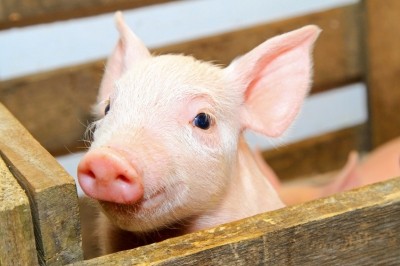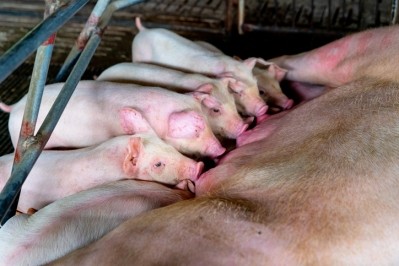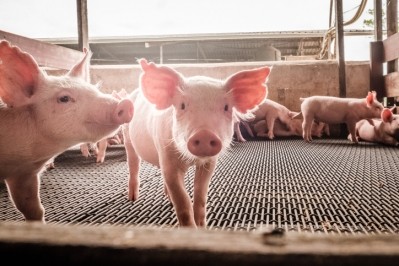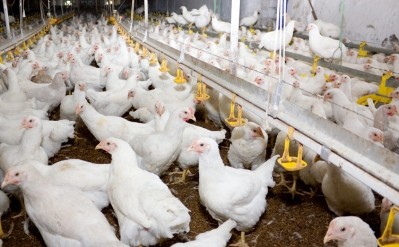Feeding fiber promotes the growth performance of piglets, say researchers

Though, they noted that a combination of insoluble and soluble fiber over the whole experiment period enabled a positive effect on growth performance, blood biochemical indices, nutrients digestibility, gut microbiota, and intestinal barrier functions.
Their study, the aim of which was to determine a suitable diet fiber supplementation strategy for weaned piglets, was published in Animal Feed Science and Technology.
Plugging data gaps on fiber use in piglet diets
At present, there is lack of consistent information in the literature about the usage of fiber, namely the type and the duration of use in weaned piglet diets, said the team.
Typically, dietary fiber is divided into soluble and non-soluble fiber according to their solubility character, they added.
It has been reported that dietary fiber could improve the intestinal health by promoting bacterial community and increasing hindgut fermentation (Kim et al., 2013; Laitat et al., 2015), preventing diarrhea (Hansen et al., 2010) and disease (Wenk et al., 2001; Chen et al., 2013), said the research team.
It has also been documented that insoluble fiber could decrease the transit time of digesta, which had a relation to reduce pathogens proliferation in the gastrointestinal tract (GIT) (Molist et al., 2014b), continued the authors.
Meanwhile, other studies have shown than insoluble fiber reduced diarrhea incidence, with that function attributed to its water holding capacity (Montagne et al., 2003; Deepak and Sheweta, 2013), they noted.
Alternatively, research has indicated that soluble fiber can serve as substrate for microbial fermentation to produce SCFAs, which affect both gut morphology and function (Drochner et al., 2010; Pascoal et al., 2015a), they said.
The different effects of the two types of fiber might be attributed to their different physicochemical properties (Molist et al., 2014a), commented the scientists.
The team said they, thus, theorized that soluble fiber and/or insoluble fiber may have different effects on piglet growth and health during different weaning stress phases.
“To determine this hypothesis, the present study investigated the effects of inulin (soluble fiber) and lignocellulose (insoluble fiber) on piglet growth performance, digestive functions, blood biochemical profile, intestinal microbiota and barrier function during 1–14 days and 15–28 days after weaning.”
The #1 event for feed industry and livestock experts is taking place in Amsterdam, 3-4 March 2020. The summit is focused on young animal nutrition, namely for piglets and broiler chicks. It will give you the opportunity to learn from and network with the best in the industry during numerous discussions and debates. Check out the full programme.
Methodology
Thirty piglets with initial body weight (BW) of 7.50 ± 0.31 kg were randomly allotted to one of five treatments with six replicates per treatment and one piglet per replicate, explained the authos.
The five dietary treatments were basal diet or control, 1% insoluble dietary fiber diet (IDF), 1% soluble dietary fiber diet (SDF), 0.75% insoluble fiber + 0.25% soluble fiber diet during the first two weeks and 0.25% insoluble fiber + 0.75% soluble fiber diet during the last two weeks (CRMDF), and 0.5% insoluble fiber + 0.5% soluble dietary fiber diet (MDF), they said.
The trial lasted four weeks.
Piglets were fed maize-soybean meal-based diets, a low-fiber basal diet, formulated to meet the nutrient recommendations of National Research Council (2012) (NRC, 2012).
The experimental diet was crumbled with a diameter 1mm. No antibiotics were used, explained the authors.
The soluble fiber inulin was provided by Ci Yuan Biotech Company Limited, based in China.
“Inulin is considered a form of soluble fiber and is rapidly fermented in the colon.”
The insoluble fiber lignocellulose was provided by Germany’s J Rettenmaier & Söhne (JRS) Group; that fiber has a high-water holding capacity, said the team. The measured concentrations of fructans and lignocellulose were 92.15% and 90%, respectively.
The experiment was conducted at the Research Base of the Institute of Animal Nutrition of Sichuan Agricultural University.
Results
The scientists found that the piglets fed the CRMDF and MDF diets showed a higher average daily gain (ADG) and lower feed: gain (F/G) than other treatments in the whole period, which they said indicated that the co-supplementation of the two fibers might be more beneficial for piglet growth performance than supplementation alone.
The team said the results showed that feeding CRMDF and MDF diets also increased the concentrations of serum total protein (TP) and albumin (ALB), which was consistent with previous study (Wang et al., 2009).
In the first two weeks of the trial, piglets fed IDF, CRMDF and MDF diets showed a higher ADG and a lower F/G than those of basal and SDF diets, a result that tallied with other papers (Pascoal et al., 2015b).
This indicates, they said, that insoluble fiber cellulose might be more effective than soluble fiber inulin on piglet growth performance during the first two weeks of post-weaning. "The reason might be related to the beneficial effect of insoluble fiber in intestinal function."
The authors stressed that due to the variation in the rate of digestion among soluble fibers or insoluble fibers, the response of co-supplementation of other soluble fibers and insoluble fibers needs to be evaluated.
Their findings need to be further verified in larger scale trials, they added.
Source: Animal Feed Science and Technology
DOI: https://doi.org/10.1016/j.anifeedsci.2019.114335
Title: Effects of soluble and insoluble dietary fiber supplementation on growth performance, nutrient digestibility, intestinal microbe and barrier function in weaning piglet
Authors: B Yu et al















